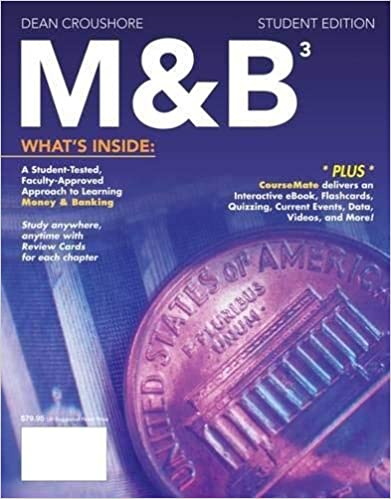
M&B3 3rd Edition by Dean Croushore
Edition 3ISBN: 978-1285167961
M&B3 3rd Edition by Dean Croushore
Edition 3ISBN: 978-1285167961 Exercise 2
Describe and explain three factors other than expected return and risk that affect the demand for fi nancial securities.
Explanation
The other three factors other than expected return and risk that affect the demand for financial securities are:
• Liquidity
• Taxability, and
• Maturity
Liquidity: Liquidity risk is the risk associated with particular secondary market in which a securities trades. An investment that can be bought or sold quickly and without significant price concession is considered liquid. The more uncertainty about the time element and the price concession the greater would be the liquidity risk.
A Treasury bill has little or no liquidity risk whereas a small OTC stock may have substantial liquidity risk. Liquid assets are highly marketable and suffer no liquidation costs. Illiquid assets are not readily marketable and suffer no liquidation costs. Illiquid assets are not readily marketable either price incurred by the seller in order to find a new investor for an illiquid assed. The more illiquid the asset is, the larger the price discounts or the commissions that must be paid to dispose of the assets.
Taxes: The amounts of interest and dividends received by investors on securities are subject to taxation. So investors not only bothers of expected rate of return but also calculates the after tax expected rate of return for owning those securities.
For instance, if an investor who has a tax rate of 40% and expects to earn a return of 10 percent before taxes has an after tax expected return of (10*.4)=4% therefore 10-4=6% after tax expected return.
Maturity: It depends on investors choice he is free to invest his saving for a long period of time for maturity in old age or if he prefers not to lock their money up for a long period of time and cash as and when need can opt for short term maturity date securities.
In order to attract the different class of investors the borrowers offer higher interest rates for long-term securities rather than for short-term maturity securities.
• Liquidity
• Taxability, and
• Maturity
Liquidity: Liquidity risk is the risk associated with particular secondary market in which a securities trades. An investment that can be bought or sold quickly and without significant price concession is considered liquid. The more uncertainty about the time element and the price concession the greater would be the liquidity risk.
A Treasury bill has little or no liquidity risk whereas a small OTC stock may have substantial liquidity risk. Liquid assets are highly marketable and suffer no liquidation costs. Illiquid assets are not readily marketable and suffer no liquidation costs. Illiquid assets are not readily marketable either price incurred by the seller in order to find a new investor for an illiquid assed. The more illiquid the asset is, the larger the price discounts or the commissions that must be paid to dispose of the assets.
Taxes: The amounts of interest and dividends received by investors on securities are subject to taxation. So investors not only bothers of expected rate of return but also calculates the after tax expected rate of return for owning those securities.
For instance, if an investor who has a tax rate of 40% and expects to earn a return of 10 percent before taxes has an after tax expected return of (10*.4)=4% therefore 10-4=6% after tax expected return.
Maturity: It depends on investors choice he is free to invest his saving for a long period of time for maturity in old age or if he prefers not to lock their money up for a long period of time and cash as and when need can opt for short term maturity date securities.
In order to attract the different class of investors the borrowers offer higher interest rates for long-term securities rather than for short-term maturity securities.
M&B3 3rd Edition by Dean Croushore
Why don’t you like this exercise?
Other Minimum 8 character and maximum 255 character
Character 255


